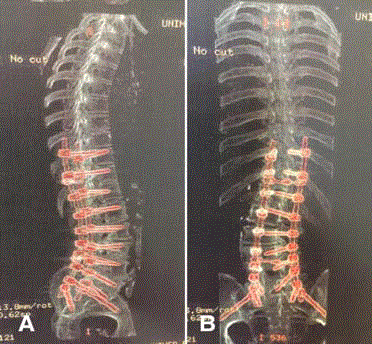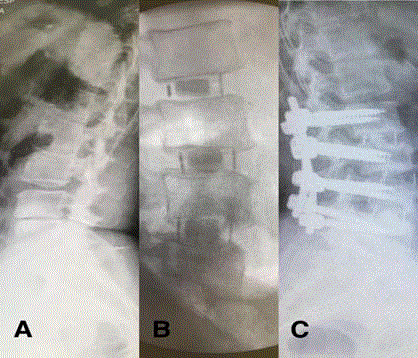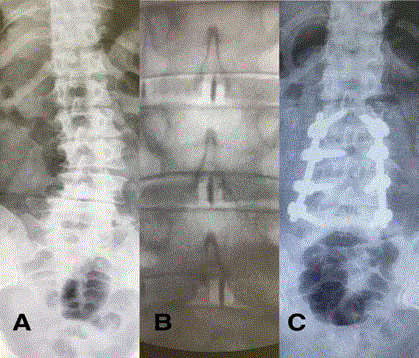Clinical Image
Extreme-Lateral Lumbar Inter Body (XLIF) Fusion plus Posterior Percutaneous Screw Fixation – A Minimally Invasive Approach to Degenerative Scoliosis
Flávio Ramalho Romero1*, Rodolfo Brum Vieira2 and Bruno da Costa Ancheschi3
1Department of Neurology, Sao Paulo State University, Brazil
2Division of Neurosurgery, Hospital das Clínicas de Botucatu, Brazil
3Division of Orthopedic and Spine Surgery, São Paulo State University - UNESP, Brazil
*Corresponding author: Flávio Ramalho Romero, Department of Neurology, Psychiatry and Psychology, Botucatu, Sao Paulo State University, Zip Code: 18.618-970, Brazil
Published: 28 Jun, 2018
Cite this article as: Romero FR, Vieira RB, da Costa
Ancheschi B. Extreme-Lateral Lumbar
Inter Body (XLIF) Fusion plus Posterior
Percutaneous Screw Fixation – A
Minimally Invasive Approach to
Degenerative Scoliosis. Clin Surg.
2018; 3: 1996.
Clinical Image
scoliosis is defined as a spinal deformity in a skeletally mature patient with a Cobb
angle of more than 10° in the coronal plain caused by progressive and asymmetric degeneration
of the disc, facet joints, and other structural spinal elements typically leading to neural element
compression. The prevalence of degenerative scoliosis ranges from 6% to 68%. With an aging
population, degenerative scoliosis has become a considerable health care concern, not only
cosmetically, but also, as a cause of significant pain and disability [1]. About 90% of patients presents
with low back pain with or without radicular leg pain and/or neurogenic claudication. Back pain is
due to instability of one or more spinal segments and consequent spinal muscle fatigue [2]. Treatment
for degenerative scoliosis is a challenging. Several factors, such as medical comorbidities, social, and
environmental, play significant roles in the outcome and the need for thorough evaluation. It is well
know that smoke, diabetes, osteoporosis, asthma or chronic obstructive pulmonary disease; coronary
or cerebrovascular disease, nutritional deficiency, and depression are related with poor clinical
outcomes or increased surgical risks [3]. Patients with intractable radiculopathy or back pain despite
concentrated non-operative therapy and with neurological deficits may be surgical candidates.
Results are heterogeneous and depend on many factors. Decompression and instrumented fusion
are the standard surgical treatment, but long segment fusion (Figure 1), sometimes including iliac
screws, is needed to achieve good biomechanical restoration. The decompression and fusion have
good results in terms of pain relief, walking ability, and patient satisfaction, but morbidity and
mortality rates are high in those patients [4].
Extreme lateral inter body fusion (XLIF – Figure 2,3) have been used as a minimally invasive
alternative to improve sagittal and coronal balance with less complication rates and significant good
outcomes in that group of patients. Here, we present an example of degenerative scoliosis patient
treated with XLIF and posterior percutaneous screw insertion, focusing on preoperative, operative
and postoperative images [5].
Figure 1
Figure 1
3D CT reconstruction of traditional open T10-iliac screw fixation for a degenerative scoliosis patient.
Figure 2
Figure 2
Anterior view comparing preoperative, intra operative and postoperative images of XLIF plus posterior percutaneous screw insertion.
Figure 3
Figure 3
Lateral view comparing preoperative, intra operative and postoperative images of XLIF plus posterior percutaneous screw insertion.
References
- Katz JN. Lumbar spinal fusion. Surgical rates, costs and complications. Spine. 1995;20(24 Suppl):78S-83S.
- Fritzell P, Hagg O, Nordwall A. Complications in lumbar fusion surgery for chronic low back pain: comparison of three surgical techniques used in a prospective randomized study. A report from the Swedish. Lumbar Spine Study Group. Eur Spine J. 2003;12:178-89.
- Patel VC, Park DK, Herkowitz HN. Lateral transpsoas fusion: indications and outcomes. The Scientific World Journal. 2012;2012:893608.
- Moller DJ, Slimack NP, Acosta FL, Koski TR, Fessler RG, Liu JC. Minimally invasive lateral interbody fusion and transpsoas approach-related morbidity. Neurosurg Focus. 2011;31(4):E4.
- Anand N, Baron EM, Thaiyananthan G, Khalsa K, Goldstein TB. Minimally invasive multilevel percutaneous correction and fusion for adult lumbar degeneratives coliosis: a technique and feasibility study. J Spinal Disord Tech. 2008;21(7):459-67.



